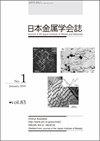不同浇注温度对添加nb的SCH13A耐热铸钢渗碳组织和蠕变性能的影响
IF 0.4
4区 材料科学
Q4 METALLURGY & METALLURGICAL ENGINEERING
引用次数: 0
摘要
研究了浇铸温度分别为1753 K、1823 K和1883 K时,加入1% nb的自硬型铸造SCH13A耐热铸钢浇注温度与渗碳组织的关系。对这些材料经反复渗碳和淬火处理后的蠕变性能进行了研究。结果表明,随着浇注温度的升高,渗碳深度减小,渗碳层内碳浓度分布增大。对蠕变性能的相对比较表明,反复真空渗碳淬火产生的初生碳化物的体积以及碳化物中空洞和微裂纹的数量影响蠕变破裂时间。渗碳试样的蠕变断裂时间比铸态试样短。此外,在1823 K浇筑时,三种浇筑温度下试样的断裂时间最长。本文章由计算机程序翻译,如有差异,请以英文原文为准。
Changes in Carburized Microstructures and Creep Properties of Nb-Added SCH13A Heat-Resistant Cast Steel due to Different Pouring Temperatures
The relationship between pouring temperature and carburized microstructure of 1%Nb-added SCH13A heat-resistant cast steel manufactured by the self-hardening mold casting process at pouring temperatures of 1753 K, 1823 K and 1883 K was investigated. The creep properties of these materials subjected to repeated carburizing and quenching treatment were also examined. As a result, with increasing pouring temperature, the carburized depth decreases and the carbon concentration distribution in the carburized layer increases. A relative comparison of the creep properties revealed that the volume of primary carbides and the number of voids and micro-cracks in carbides generated due to repeated vacuum carburizing quenching treatment affected the creep rupture time. Creep rupture time of the carburized specimens was shorter than that of the as-cast specimens. Additionally, pouring at 1823 K exhibits the longest rupture time among the samples poured at three different temperatures.
求助全文
通过发布文献求助,成功后即可免费获取论文全文。
去求助
来源期刊

Journal of The Japan Institute of Metals
工程技术-冶金工程
CiteScore
0.70
自引率
0.00%
发文量
27
审稿时长
6-12 weeks
期刊介绍:
Information not localized
 求助内容:
求助内容: 应助结果提醒方式:
应助结果提醒方式:


